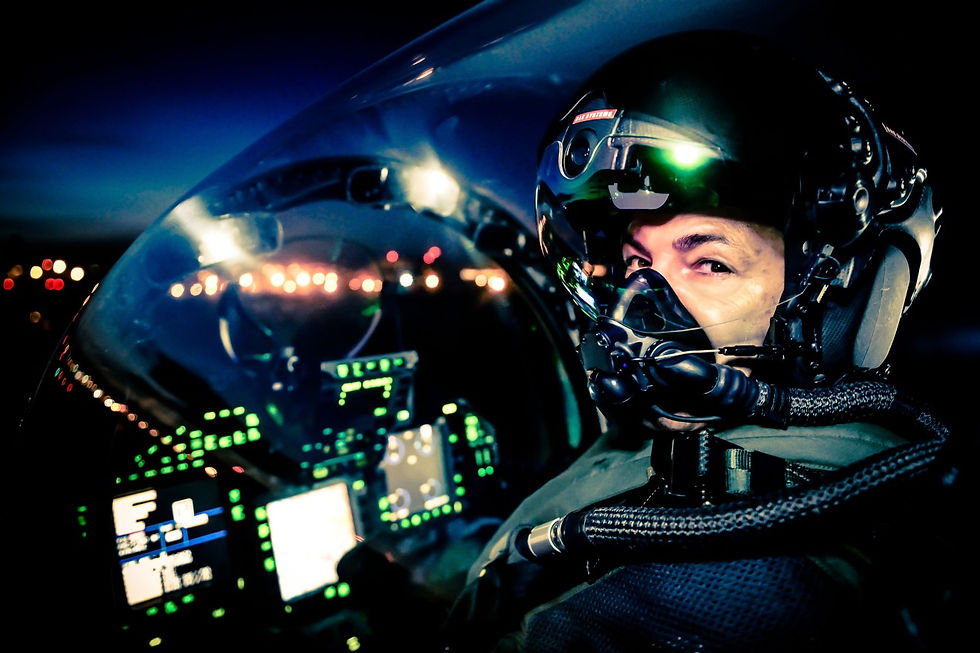Flying into the Future: Advanced Fighter Helmets Set to Revolutionise Eurofighter Cockpits
- Oscar Noone

- Dec 16, 2024
- 3 min read
Updated: Jan 17

After it was announced earlier this week there would be a £133 million injection of funding, the Eurofighter Typhoon, already a marvel of modern aviation, is taking another leap forward with the introduction of the Striker® II Helmet-Mounted Display System. This cutting-edge helmet promises to redefine how pilots interact with their aircraft, bringing a futuristic edge to the skies.
But why should aviation enthusiasts, young or old, care about this piece of high-tech gear? Let’s start with how this next-gen piece of equipment functions.
Beyond the Ordinary: How the Striker® II Works

Picture this: you’re flying in a combat scenario, straining under 5-9G's (multiples of gravity acting on the pilot) of force- with your cone of vision narrowing, all whilst another jet is hunting your aircraft with aims to inflict harm upon you.
Instead of glancing down at multiple cockpit instruments, all the critical information that you need to effectively fly the jet is displayed directly in front of your eyes, overlaying the real world. The Striker® II does just that, combining data, tracking, and night vision into a single system.
This isn’t your standard fighter helmet. The Striker® II offers:
Integrated Night Vision: No bulky goggles. Night vision is built into the helmet, offering a clear view even in low-light missions.
Augmented Reality (AR): Flight and mission data, targeting systems, and navigation cues are seamlessly projected onto the visor. It’s like playing a video game—except it’s real.
Precision Head Tracking: Sensors align the displayed information with the pilot’s exact line of sight. If a target moves, the helmet adjusts in real time, ensuring the pilot’s focus never falters.
Enhanced Comfort: Long missions can be exhausting. The Striker® II is designed to reduce fatigue with improved ergonomics, a game-changer for pilots enduring hours of high-intensity flying.
Aviation Meets Sci-Fi
The Striker® II feels as if Top Gun met Star Wars. It uses AR (Augmented Reality) technology similar to what we see in gaming headsets but adapted for the harsh realities of aerial combat. Whether it’s locking onto an enemy jet, pinpointing a ground target, or navigating through adverse weather, the helmet ensures that the pilot remains fully aware of their surroundings without distraction.
This is a huge leap for fighter pilots who operate in rapidly changing environments where a split-second decision can mean the difference between life and death.
The Eurofighter Typhoon’s Role in Global Defense

The Eurofighter Typhoon is already a cornerstone of NATO’s defense fleet. With its incredible agility, advanced radar systems, and multi-role capabilities, it’s designed to excel in air-to-air combat, ground attack, and reconnaissance missions. Rumored to be an addition to the upgraded 'Tranche 5' Eurofighter in development, the addition of the Striker® II helmet only enhances its capabilities.
So, what’s the big picture? This upgrade isn’t just about making the Typhoon more effective—it’s about maintaining an edge in a competitive global defense landscape. Nations like Russia and China are developing advanced fighter technologies, such as the Sukhoi Su-57 and the Chengdu J-20. Tools like the Striker® II ensure that Western aircraft remain at the forefront.
The Ripple Effect: How Military Innovation Impacts Civil Aviation
You might wonder: Why should I care about a fighter pilot’s helmet? The truth is, many of the technologies we take for granted in commercial aviation started in the military. Radar, GPS, and even in-flight Wi-Fi trace their roots back to military innovations.
The AR tech in the Striker® II could one day influence civilian cockpits, enhancing pilot safety and efficiency. Imagine commercial pilots having a similar system to navigate bad weather or manage emergencies with unparalleled clarity.
The Bigger Questions
As exciting as this technology is, it raises important questions about the future of aviation and defense:
Will autonomous systems overtake human pilots? With drones and AI gaining ground, will helmets like the Striker® II become obsolete in a few decades?
What are the ethical implications of enhanced combat technology? As warfare becomes more tech-driven, how do we ensure accountability and control?
How far can AR tech go in aviation? Could we one day see AR overlays for passengers in commercial flights, turning your window seat into a learning experience?

What This Means for The Next Generation of Fighter Pilots
For anyone passionate about aviation, the Striker® II is a reminder that this field is constantly evolving. Whether you dream of flying jets, designing aircraft, or innovating new technologies, the possibilities are endless.
So, what’s your take? Are you excited by the idea of advanced fighter helmets like the Striker® II? Do you think this technology has a place in civilian aviation, or is it better left in military hands? The future is wide open—and we are the next generation to shape it.




Comments